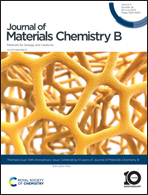Leveraging peptide–cellulose interactions to tailor the hierarchy and mechanics of peptide–polymer hybrids†
Abstract
Inspired by spider silk's hierarchical diversity, we leveraged peptide motifs with the capability to tune structural arrangement for controlling the mechanical properties of a conventional polymer framework. The addition of nanofiller with hydrogen bonding sites was used as another pathway towards hierarchical tuning via matrix–filler interactions. Specifically, peptide–polyurea hybrids (PPUs) were combined with cellulose nanocrystals (CNCs) to develop mechanically-tunable nanocomposites via tailored matrix–filler interactions (or peptide–cellulose interactions). In this material platform, we explored the effect of these matrix–filler interactions on the secondary structure, hierarchical ordering, and mechanical properties of the peptide hybrid nanocomposites. Interactions between the peptide matrix and CNCs occur in all of the PPU/CNC nanocomposites, preventing α-helical ordering, but promoting inter-molecular hydrogen bonded β-sheet formation. Depending on peptide and CNC content, the Young's modulus varies from 10 to 150 MPa. Unlike conventional cellulose-reinforced polymer nanocomposites, the mechanical properties of these composite materials are dictated by a balance of CNC reinforcement, peptidic ordering, and microphase-separated morphology. This research highlights that leveraging peptide–cellulose interactions is a strategy to create materials with targeted mechanical properties for a specific application using a limited selection of building blocks.

- This article is part of the themed collection: Celebrating ten years of Journal of Materials Chemistry B


 Please wait while we load your content...
Please wait while we load your content...
